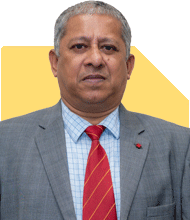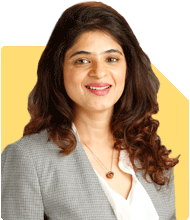How Can I Retire at 55 with 1.5 Lakh/Month?
Ramalingam Kalirajan |8459 Answers |Ask -Follow
Mutual Funds, Financial Planning Expert - Answered on Aug 28, 2024
He has an MBA in finance from the University of Madras and is a certified financial planner.
He is the director and chief financial planner at Holistic Investment, a Chennai-based firm that offers financial planning and wealth management advice.... more

Hello Sir I am 46 year old. I have wife and 2 kids . Daughter is going for study at abroad, son is in 9 th . Following is my investment and loan . Home loan 25 L remaining emi 24 K , Car loan 3 L remaining emi 8 K. Investment 77 L FD , 18 L mutual fund ( 50 K per month) , epf 76 L , ppf 30 L, other gold/ shares 4 L and 3.4 L NSC post office. I earn 2 L per month and my wife 55 K . We require for daughter eduction 7 L per annum for next 6 years and son education after 4 year may be 7 L for 4 years. We want retirement at 55 with 1.5 L per month please suggest how to achieve this
Your daughter's education costs will be Rs. 7 lakh annually for the next six years. Your son's education will require Rs. 7 lakh annually starting in four years for a period of four years. Additionally, you plan to retire at 55, with a desired monthly income of Rs. 1.5 lakh.
Financial Goals
1. Funding Education Expenses
Your immediate priority is securing funds for your children's education. For your daughter, you need Rs. 42 lakh over six years. For your son, you need Rs. 28 lakh starting in four years. These goals are crucial and require a robust plan.
2. Retirement Planning
You wish to retire at 55, with a target of Rs. 1.5 lakh per month. With nine years to retirement, it's essential to align your investments to ensure this target is met.
3. Loan Repayment
Paying off your home and car loans will free up cash flow, which can be redirected to other investments.
Strategic Financial Planning
1. Optimizing Loan Repayment
Home Loan: You have Rs. 25 lakh remaining on your home loan. With an EMI of Rs. 24,000, the remaining tenure is likely long. Consider prepaying a portion of this loan. Prepayment will reduce the tenure and save interest. You could use a part of your FD to do this. This action will free up Rs. 24,000 per month in the future.
Car Loan: The outstanding amount is Rs. 3 lakh with an EMI of Rs. 8,000. Given the smaller loan size, it’s advisable to pay this off early. You could use your savings or FD for this. This will free up Rs. 8,000 per month.
2. Investment Strategy for Education
Daughter’s Education: Rs. 7 lakh per annum for six years will need Rs. 42 lakh. You already have Rs. 77 lakh in FD, which is a safe option. However, considering inflation, it’s wise to ensure that these funds are not only secure but also growing. You might want to move some of these funds into a balanced mutual fund or a debt mutual fund. This will offer a better return than FD while still being relatively low-risk.
Son’s Education: Rs. 7 lakh per annum for four years, starting in four years, will require Rs. 28 lakh. You have time to grow this fund. Continue your current SIPs and consider increasing the amount. Mid-cap and small-cap funds can provide higher returns, but they come with higher risk. Since you have time, a mix of equity mutual funds is advisable.
3. Retirement Planning
Current Savings: Your EPF (Rs. 76 lakh) and PPF (Rs. 30 lakh) are solid foundations. Continue contributing to them. Additionally, your Rs. 18 lakh in mutual funds should continue growing. With Rs. 50,000 per month in SIPs, your portfolio will grow significantly over the next nine years.
Diversifying Investments: To achieve Rs. 1.5 lakh per month in retirement, you’ll need a combination of safe and growth-oriented investments. Continue with mutual funds but consider adding debt funds and conservative hybrid funds as you near retirement. This will protect your corpus from market volatility.
4. Building a Contingency Fund
Emergency Savings: With your current income, you should set aside at least six months' worth of expenses in a liquid fund. This would be about Rs. 18 lakh. Your FDs could partially serve this purpose, but you might also consider a separate contingency fund.
5. Health and Insurance Coverage
Health Insurance: Ensure you have adequate health insurance coverage for your entire family. Medical costs can be a significant burden, especially in retirement. If your current coverage is below Rs. 10-20 lakh, consider enhancing it.
Life Insurance: Review your life insurance needs. Your outstanding loans and future obligations mean you should have sufficient coverage. A term plan is the most cost-effective way to secure this.
Detailed Financial Recommendations
1. Education Funding
Daughter’s Education: Allocate Rs. 7 lakh per annum from your FD. Invest the remaining FD in a balanced mutual fund to keep pace with inflation. This approach balances safety and growth.
Son’s Education: Use your mutual fund SIPs to build this corpus. Consider increasing your SIPs if possible, to ensure you have Rs. 28 lakh by the time he needs it.
2. Prepay Loans
Home Loan: Consider prepaying Rs. 10-15 lakh from your FD. This will significantly reduce your loan tenure and interest burden.
Car Loan: Clear this loan as soon as possible. Use Rs. 3 lakh from your savings or FD to eliminate this EMI. This will increase your monthly cash flow.
3. Retirement Investments
Continue EPF and PPF Contributions: These are your safest investments. Ensure you’re maxing out your PPF contributions annually.
Increase Equity Exposure: Continue with your Rs. 50,000 SIPs. As you get closer to retirement, shift part of your portfolio to less volatile funds. This could include conservative hybrid funds or large-cap funds.
Explore Debt Funds: As you near retirement, consider moving a portion of your mutual fund corpus into debt funds. These provide stability and regular income, which aligns with your retirement goals.
4. Emergency Fund and Insurance
Create a Contingency Fund: Set aside Rs. 18 lakh for emergencies. This fund should be easily accessible, like in a liquid mutual fund.
Review Health Insurance: Ensure your family’s health insurance is adequate. Top up if necessary to cover Rs. 10-20 lakh per person.
Secure Life Insurance: Ensure you have a term insurance plan that covers your outstanding loans and future financial responsibilities.
Final Insights
You have a solid foundation, but optimizing your investments and managing your loans will help you achieve your financial goals. Prioritize your children's education, as these are immediate and significant expenses. Simultaneously, work towards clearing your loans to free up cash flow. Your retirement goal of Rs. 1.5 lakh per month is achievable with disciplined investing and strategic planning. Regularly review your financial plan, adjust as necessary, and keep your goals in focus.
Best Regards,
K. Ramalingam, MBA, CFP,
Chief Financial Planner,
www.holisticinvestment.in
You may like to see similar questions and answers below
Milind Vadjikar |1236 Answers |Ask -Follow
Insurance, Stocks, MF, PF Expert - Answered on Oct 17, 2024
Ramalingam Kalirajan |8459 Answers |Ask -Follow
Mutual Funds, Financial Planning Expert - Answered on Oct 18, 2024
Ramalingam Kalirajan |8459 Answers |Ask -Follow
Mutual Funds, Financial Planning Expert - Answered on Nov 07, 2024
Dr Nagarajan J S K |406 Answers |Ask -Follow
NEET, Medical, Pharmacy Careers - Answered on May 16, 2025

Based on my understanding, no one usually requests a birth certificate at this age. Your inquiry relates to the period before and after independence. In those days, they would accept the SSLC book if you didn't have a birth certificate. However, I am not sure if that was the case during your time.
Instead, you can present your Aadhaar card, which likely includes your original date of birth. You can utilize that information.
If my response doesn't fully address your concerns, I recommend consulting a Notary Public for further assistance.
BEST WISHES.
THANK YOU SIR.
with regards
Prof Suvasish Mukhopadhyay |651 Answers |Ask -Follow
Career Counsellor - Answered on May 16, 2025
Prof Suvasish Mukhopadhyay |651 Answers |Ask -Follow
Career Counsellor - Answered on May 16, 2025
Radheshyam Zanwar |1634 Answers |Ask -Follow
MHT-CET, IIT-JEE, NEET-UG Expert - Answered on May 16, 2025
Radheshyam Zanwar |1634 Answers |Ask -Follow
MHT-CET, IIT-JEE, NEET-UG Expert - Answered on May 16, 2025
Ashwini Dasgupta |107 Answers |Ask -Follow
Personality Development Expert, Career Coach - Answered on May 16, 2025
Ramalingam Kalirajan |8459 Answers |Ask -Follow
Mutual Funds, Financial Planning Expert - Answered on May 16, 2025
Ramalingam Kalirajan |8459 Answers |Ask -Follow
Mutual Funds, Financial Planning Expert - Answered on May 16, 2025
Milind Vadjikar |1236 Answers |Ask -Follow
Insurance, Stocks, MF, PF Expert - Answered on May 16, 2025
Milind Vadjikar |1236 Answers |Ask -Follow
Insurance, Stocks, MF, PF Expert - Answered on May 16, 2025























